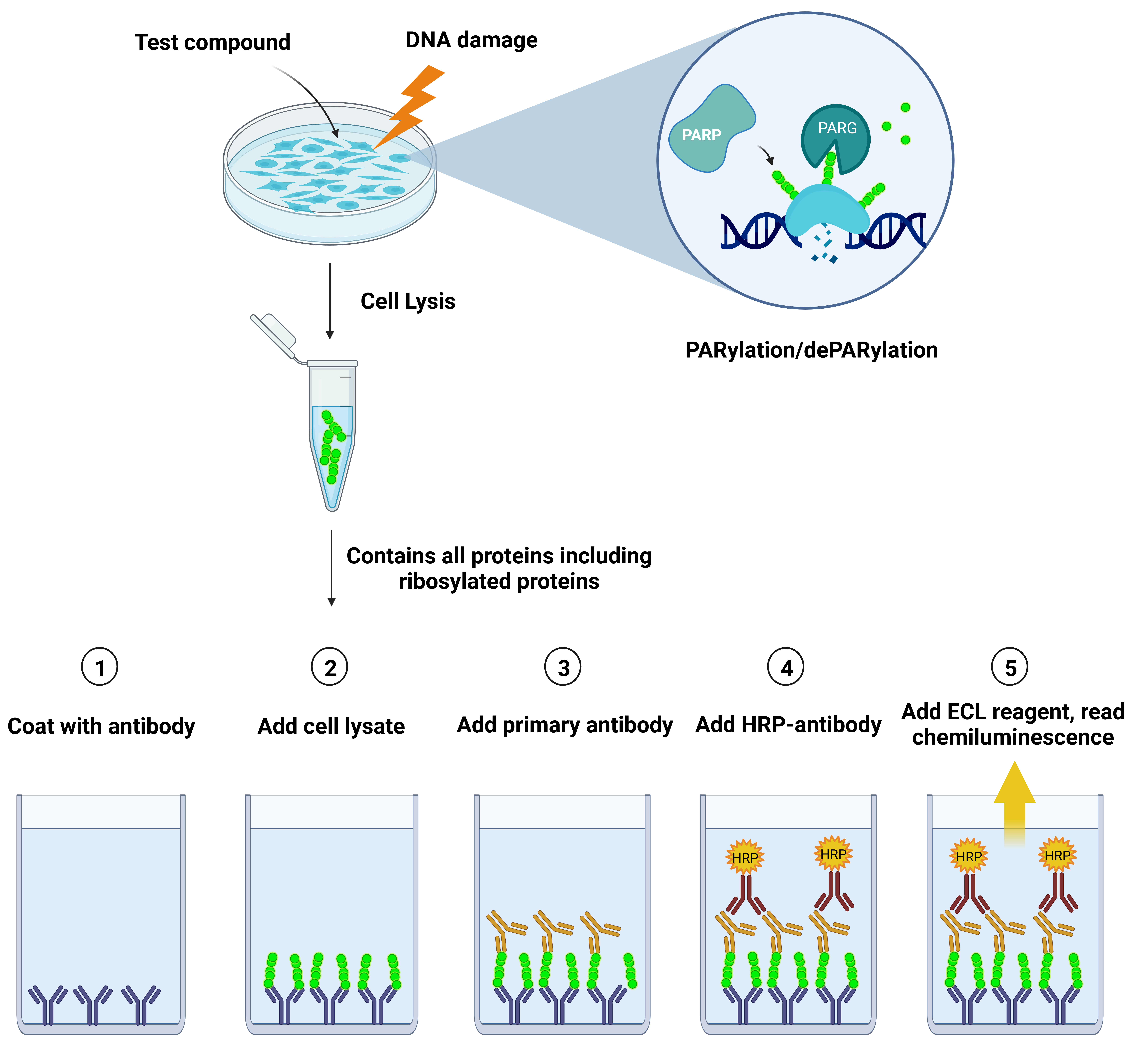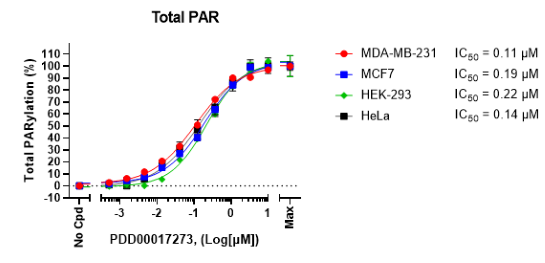LysA™ Universal PARylation Assay Kit
LysA™ Universal PARylation Assay Kit is a sandwich ELISA-based kit designed to measure and quantify the amount of total poly ADP-ribosylation present in cell extracts. The kit comes in a convenient 96-well format and contains all the reagents needed, including a PAR standard that allows to establish a standard curve for quantitative measurements. It contains enough antibodies, blocking buffer, and detection reagents to measure PARylation levels in cell extracts, in a 96 well plate format. It also includes cell lysates as controls for assay performance.
Note: The assay is adequate for Poly-ADP-ribosylation detection only. The assay is linear in the 100 pM to 20 nM PARylation range.

Figure 1: LysA™ Universal PARylation Assay workflow diagram.
An anti-PAR antibody is used to coat the 96-well plate. Lysates from cells are added to the coated wells, so PAR (PARylated proteins) present in the cell lysates are captured by the antibody. This is followed by an incubation with an anti-PAR primary antibody and a secondary HRP-labeled antibody. Addition of a chemiluminescent HRP substrate provides a luminescence signal, which directly correlates with the amount of PAR present in the cell extracts
- Modified RIPA Lysis Buffer (Moderate Strong) (BPS Bioscience #82126)
- LysA™ Protease Inhibitor Cocktail Kit (BPS Bioscience #82199)
- ADP-Ribosylation Cycle Inhibitor Mix (BPS Bioscience #82130)
| Catalog # | Name | Amount | Storage |
| 10 µM PAR Standard | 6 μl | -80°C | |
| Anti-PAR Coating Antibody | 10 μl | -80°C | |
| Anti-PAR Detection Antibody | 10 μl | -80°C | |
| 82156 | HEK293 High PAR Cell Lysate | 300 µl | -80°C |
| 82157 | HEK293 Low PAR Cell Lysate | 300 µl | -80°C |
| 52131H | Secondary HRP-Labeled Antibody 2 | 10 μl | -80°C |
| 79743 | Blocking Buffer 3 | 2 x 25 ml | +4°C |
| 79670 | ELISA ECL Substrate A | 6 ml | Room Temp |
| ELISA ECL Substrate B | 6 ml | Room Temp | |
| 79837 | 96-well module Maxisorp™ plate | Room Temp |
PAR homeostasis is regulated by the family of PAR polymerases (PARPs) and PARG (Poly (ADP-ribose) glycohydrolase) in response to cellular stress conditions. ADP ribosylation, which is the addition of an ADP-ribose to a protein, is a reversible post-translational modification of proteins mostly involved in the DNA Damage Response (DDR) pathway. Poly-ADP-ribosylation (termed PARylation) is the addition of linear or branched chains of ADP-ribose. PARP and PARG activity are linked to cellular responses in inflammation, ischemia, stroke, and cancer. PARP inhibitors have been used in cancer treatment with success, leading to synthetic lethality when homologous recombination repair (HRR) is already defective. PARG is overexpressed in breast cancer and associated with tumor growth and survival. Decrease in PARG activity can potentiate the effect of current cancer therapies, such as chemotherapy and radiation, making PARG inhibition with selective inhibitors a promising approach in cancer and immunotherapy. Further studies of PARP and PARG will elucidate how the levels of PARylated proteins contribute to disease and can be modulated to provide therapeutic benefit.
Marques M., et al., 2019 Oncogene 38 (12): 2177-2191.
James D. I., et al., 2016 ACS Chem Biol 11 (11): 3179-3190.
Drown B. S., et al., 2018 Cell Chem Bio 25 (12): 1562-1570.




